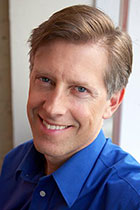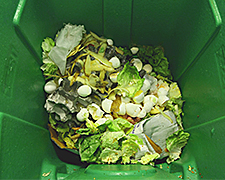San Francisco, the first urban area in the nation to mandate recycling and composting and begin outlawing items like Styrofoam food containers, aims to completely eliminate the trash it sends to landfills by 2020. For the past two decades, Jack Macy has helped steer the city toward that goal.
Macy, the senior Commercial Zero Waste coordinator for the city and county Department of the Environment, spearheaded most of San Francisco’s groundbreaking waste-reduction legislation, including requiring construction debris recycling (2006), banning plastic checkout bags in retail and grocery stores (2007, expanded in 2012), and making businesses and residents separate recyclables and food waste from their trash (2009). The city now recycles or composts 80 percent of its garbage, more than double the national average. And the firsts continue — in March, San Francisco passed a new law phasing out sales of disposable water bottles on city property.

In an interview with耶鲁环境360contributor Cheryl Katz, Macy discusses San Francisco’s vision for a zero-waste future, why its nearly 850,000 residents and more than 65,000 businesses make such efforts to keep their garbage out of landfills, and how obstacles like residents’ fears of “trash police” were overcome. While San Francisco has made tremendous progress, Macys says further changes are needed on both sides of the trash equation. “Part of the principle of zero waste is that the local government can’t shoulder all the burden,” he said, “So it’s important that we encourage consumers to take responsibility for what they buy and producer responsibility for the products they design and market.”
“如果我们看被认为是浪费的东西,它实际上是有价值的材料。”
耶鲁环境360:Please explain the zero-waste concept and why it’s an important issue.
杰克·梅西(Jack Macy):我认为重要的是看大自然 - 在本质上,所有废物都在生态系统中使用,并且是一种资源。而且,如果我们看被认为是浪费的东西,它实际上是有价值的材料。因此,“零废物”承认废弃材料作为宝贵资源的固有价值。
对于我们在垃圾填埋场中处置的每吨材料或在焚化炉中燃烧,以替换这些产品,我们必须去提取通常的原始资源,原材料。这种提取过程以及炼油,制造和运输,导致造成多倍的废物 - 平均是废物量的70倍以上。因此,如果我们可以减少,重复使用或回收该吨,那么我们将节省多达70吨。
E360:And what about the materials in the landfill?
梅西:除非我们在将来回去并挖掘它们,否则垃圾填埋场中的这些材料基本上会被浪费掉 - 我认为我们可能会做。但是,一旦将它们混合在一起,您就会降解它们并污染它们。另外,当您将材料放入垃圾填埋场(如果是有机材料)中时,它们会产生大量的甲烷排放。然后,您会产生浸出和其他污染 - 您还会产生所有其他影响。所有这些都是不可持续的。因此,如果我们想朝着可持续的系统迈进,那么零废物是一种愿景。
E360:San Francisco is, I think it’s fair to say, the nation’s zero waste exemplar. So where does San Francisco’s garbage go?
梅西:我们正在通过回收和堆肥以及一定数量的减少努力来转移它。我们已经为所有部门开发了全面的源分离计划。
We have blue containers for recycling, and all recyclables go in there — paper products, cardboard, newspaper, mixed paper, plastic, metal, glass containers, and all rigid plastics. Then we have a green bin for all our compostables, which includes all food scraps, even meat. All of it will compost in a high-temperature commercial compost facility. We also take in paper fibers, like food-soiled paper and greasy pizza boxes, that would otherwise not be recyclable. We include a wide range of foodware paper products, as well as certified compostable plastics that are part of the food stream. And of course plant debris, garden and yard trimmings.
“One of the biggest fears is that we would have ‘garbage police’ looking into people’s bins.”
第三种颜色是黑色的,这确实是剩下的 - 不可堆肥或可回收。那是垃圾填埋场。随着时间的流逝,我们发现至少有90%的人扔掉的东西可以进入蓝色和绿色。因此,我们的黑色数量减少了。
E360:And so you’re at 80 percent of refuse being diverted from landfills, but you think it could easily be 90 percent?
梅西:我不会容易说。[笑]从理论上讲,我们的收藏量可能达到90%。但是,即使是我们在蓝色和绿色中不接受的材料,我们也可以回收。一个很好的例子是纺织品。很长一段时间以来,纺织品回收了。即使是我们不想要蓝色和绿色的塑料袋,人们也可以将它们带回许多商店进行回收。因此,我们可能会超过90%,但我们认识到我们正处于艰难的位置,超越了我们的位置。因此,我们将不得不继续努力并获得更多创造力。
E360:In the early days when you first started working on waste reduction for San Francisco, what was the scenario here? How much trash was being generated and thrown out, and where was it going?
梅西:When I came here in 1994, we were around 30 to 35 percent diversion [from the landfill], and we were focused on how are we going to get to 50 percent by the year 2000. That felt like a real stretch.
At the time people were given two open boxes, or recycling crates, and they separated all their paper, fiber, and cardboard and their bottles and cans. There was no composting collection at all. Our disposal was going up. We were landfilling more materials. People were often putting out overflowing garbage cans. People often had stuff in bags.
E360:现在收藏当天看起来像什么?
梅西:Now you have these three, 32-gallons bins. And what you’re seeing is that people are putting out the green and the blue just about every week. That took some time over this last decade, because in the beginning people weren’t putting out their green cart every week. Now, people are putting out much more material in their green and their blue than in their black. And their black is often half empty or less.
“It’s important to encourage consumers to take responsibility for what they buy and where they put it.”
E360:Since you started working on this issue for the city, San Francisco has achieved a number of firsts in its effort to reduce waste. What were some of the biggest obstacles you encountered?
梅西:我认为最大的恐惧之一是,我们会一直在看着人们的垃圾箱,以罚款的人打耳光。我们说的是:“我们希望将其用作外展工具,并希望能够执行和罚款。但这确实是最后的手段。”
我们将与企业合作,以帮助他们设置该计划。而且,我们进行了激励措施,为回收和堆肥提供了经济利益。除了做正确的事情之外,我们拥有的最大动力就是经济 - 能够节省您在服务上支付的利率。
E360:What happens to people who don’t go along with the requirements to recycle and separate out their compostables?
梅西:We work closely with our private service provider,复发学, and we get the lists of their accounts that did not have recycling or composting. We send them a compliance letter. Generally it works, and sometimes it takes more threatening letters. There have been some businesses that have been fined because they didn’t want any service. We do have a lot of tools — we have three different agencies that can either levy fines or liens. The bottom line is we don’t want to see any recyclables and compostables in the black bin. And that’s our bottom-line compliance check.
E360:Where do things stand today?
梅西:I think we’ve done a really good job of getting a comprehensive, convenient, source-separation program in all sectors with nearly everybody on the program. And that’s been a great success. Our challenge now is, we’re shifting our efforts to help people participate better, to capture more materials and to reduce their contamination. We have leveled off, so we need to work harder, and I think that’s going to continue to be education — you can never do too much education.
For us, a key part of zero waste is the highest and best use of material. And if people separate the material, then it’s easier to process it and you have a higher quality material to recycle or compost. So maximizing source separation is really important. How far we can go we really don’t know. We think we can go further than this.
E360:And what’s in that holdout?
梅西:Some of it is plastic bags. And there are other things like textiles, and certain things that shouldn’t go in the black bin that are hazardous, like batteries and light bulbs and paint and other materials.
“People support sustainability if it doesn’t feel like too much of a burden.”
We’re working to shrink that. But part of the principle of zero waste is that the local government can’t shoulder all the burden, so it’s important that we encourage consumers to take responsibility for what they buy and where they put it when they’re done with it, and producer responsibility for the products they design and market. Producer responsibility is very important, and some of the policies we’ve pushed, — [banning plastic shopping bags, requiring food take-out containers to be recyclable or compostable, and restricting sales of disposable water bottles] — get at both of those.
It is hard at the local level to do as much as we’d like, so we work at the state level to help push policies. We just got good producer responsibility legislation passed in California on mattresses. We’ve had it on paints; hopefully we’ll get it on batteries. So we’re seeing progress.
E360:How much does all this recycling and composting cost, and who pays for it?
梅西:整个系统是通过住宅(和企业)支付的[垃圾收集]利率来资助的。家庭家庭平均每月支付34美元以上的费用。与该国其他地区相比,这听起来可能很多,但是我们在该国的劳动率最高。
E360:您认为是什么使旧金山居民和企业愿意支付额外费用并采取所有这些额外的步骤以最大程度地减少垃圾?
梅西:人们喜欢这样的事实,他们可以回收很多东西并堆肥所有食物碎片。我们的沟通讨论了堆肥的巨大好处,以及堆肥如何返回到农场和土壤中的健康食品。这是回到城市的,所以我们正在关闭营养有机堆肥环,这是一个很棒的可持续性故事。
人们喜欢在这里拥有健康的环境,并且如果感觉不到太多的负担,他们会支持可持续性。
E360:So how hard do you think this would be to do for other cities — larger cities like New York City or Houston or cities outside the Bay Area?
MORE FROM YALE e360

What advice do you have for them?
梅西:这是一个相当简单的常识系统。使用图片对其进行颜色编码。拥有易于使用的程序。良好的教育和良好的反馈。经济激励措施确实有帮助,尤其是在商业方面。最终,每个人都需要按照相同的规则发挥作用,因此强制性参与也很有意义。
With those key ingredients, we’ve demonstrated that you can go really far, and we don’t see why other cities can’t. We have our own challenges with being a very dense, urban city, very multilingual and cosmopolitan. We’ve been able to overcome those challenges and we think others can too.
E360:那个人呢?人们可以减少自己家中的浪费吗?
梅西:我认为人们需要看他们购买的东西。显然,包装较少,批量购买,购买可以回收和堆肥的材料购买,然后意识到要放在哪里。面对挑战,看看您可能浪费多少。